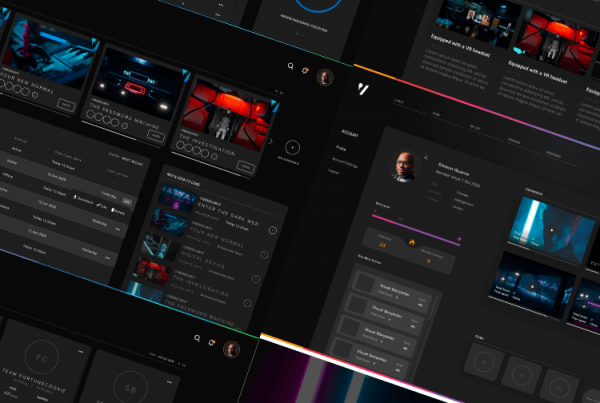![]()
It’s no surprise that sound is one of the most important things to consider when crafting a virtual learning environment. Poor use of sound design has the potential to be disorienting, whereas proper usage can provide a responsive, polished experience that can actively improve someone’s ability to learn.
Some sounds imbue negative emotions such as annoyance or agitation. Scientific American notes that some noises can go as far as to increase blood pressure due to the effect they have on stress levels. Using an irritating sound in a learning environment could negatively affect someone’s ability to concentrate.
This is why we like to take the utmost care in regard to the sounds we use throughout our online experiences, because everything you hear can have drastic effects on tone, clarity and a person’s ability to concentrate on a specific subject matter.
Ear-Cons help flag user actions
Similar to how an icon can visually flag a specific action for the user, the affectionately named ear-cons function in a similar way, providing auditory feedback to let you know if and when an action has been performed. A button press, a page refresh; whenever sound is used to punctuate action, you’re hearing an ear-con.
In our Working From Home Module the first task requires the employee to quickly identify and click on a variety of potential cyber security risks. A short congratulatory bleep tone accompanied by the guide is played each time they click a correct item. This confirms to the user that their action was appropriate whilst also instilling a small sense of pride because of the positive ring the sound has to it. Or put simply, it sounds happy, which makes us feel like we have done something right!
Congratulatory Bleep Tone
Each environment speaks a thousand words
You hear an ominous hum, the computer beeps a thousand different tones in the corner of the room. Ambient noise can be a great tool if ever you need to set the scene. However, there are many other uses it can have to improve the effectiveness of an employee training experience.
At the end of our Phishing Simulator, we ask employees to sift through examples of scam emails to decide whether or not they are safe to engage with. After tackling the first few emails, the employee starts being timed as they complete the task, audio of a clock starts ticking down, and instantly time pressure is applied.
Time Pressure Audio
Although the task isn’t any more demanding in terms of what the employee has to do, the constant ticking is overbearing. Usually this might be considered a misstep in design, here however, putting pressure on the employee helps test their abilities. By using the ticking clock we gamify the task, which challenges them and calls for further concentration.
Moments later, we escalate the situation by adding distracting office-related background noises. A printer operating, a co-worker coughing, phones ringing endlessly over the top of constant chatter. All of a sudden, the employee moves from a timed test environment into a situation analogous with their own working reality. The user can no longer relax within the theoretical and has to act quickly in applying their knowledge to reality.
Ambient Office Audio
By using ambient noise we are also able to place participants into specific environments. In our Working From Home training experience, there’s a section that talks about leaving your window open and accidentally leaking sensitive information to potential eavesdroppers. In the background, we provide ambient noise of birds tweeting and people chattering to call upon an employee’s lived-in experience.
Ambient Outside Noise Audio
Everyone knows what it sounds like to leave a window open. In drawing upon the common audio cues anyone can recognise, we firmly plant them in the moment, making the information much more vivid and memorable.
Providing clarity with voice over
For some, simply reading information on a page is not enough. That doesn’t mean it’s not an effective way to teach, it’s just acknowledging that we all have different ways of learning. For most people, hearing information can be an extremely effective way of learning, this is where our voice-overs do a lot of the heavy lifting.
Our voice-overs are always welcoming, delivering dialogue with a light-hearted tone. This approach makes an often complex subject matter easier to understand and absorb since we enjoy listening to them. It’s important dialogue is also delivered with clarity, so that the listener doesn’t hear the wrong thing only for the information to become confused.
Voice-overs also help massively in regard to accessibility, by ensuring that anyone who may have difficulty reading or be otherwise unable to experience the content visually may rely upon the audio.
Example voice over
Music in the right moment
Research at large underlines that the use of music has a profound effect on a person’s experience, especially where mood is concerned. For this reason we always ensure the music fits the tone of a specific moment. The majority of our training modules are introduced with an ominous piece of music that ratchets up the stakes and allows us to relay the importance of a specific cyber security topic. However, the tone is broken slightly with the sound of a triumphant horn toward the end, to reassure the audience that they are more than able to succeed.
But sometimes what’s much more effective than picking the right track is knowing when not to use one at all. Whenever focus is required, we make sure things stay silent so that the employee can give their full attention to the task at hand without being distracted by music.
Likewise, the intermediary sections of our team building escape rooms are almost entirely silent, save for a small amount of ambient background noise. The lack of music gives time for the team to communicate with one another, since sometimes music can become distracting and hard to talk over if it is too loud. This gives a group time to communicate and strengthen their relationship, allowing them to become a much stronger team.






